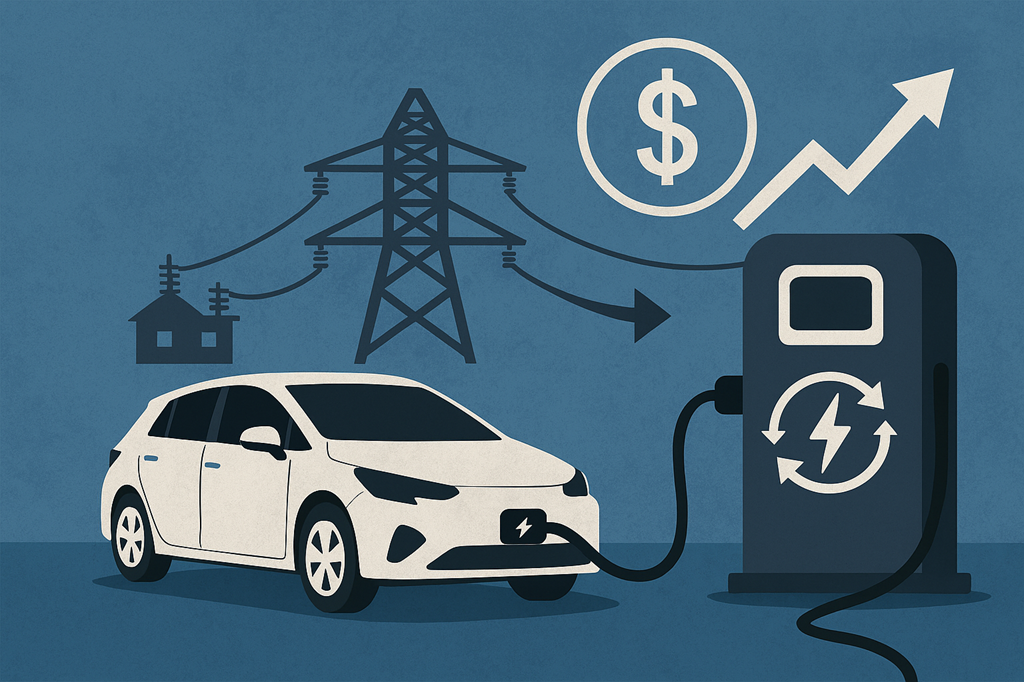
🔌 Welcome to the first edition of V2G News!
In this issue, we spotlight two must-read pieces: a groundbreaking UCS study revealing that bidirectional EVs could unlock over $11 billion annually in grid savings for California, and the debut of our V2G Value Series, which expands the conversation beyond grid services to include cost savings and resilience for EV owners. We also round up the top V2G stories from this summer to keep you current on the momentum building behind bidirectional charging with V2G technology.

V2G Insights
V2G Value Series: Thinking Beyond the Grid

This is the first in a series of articles exploring the full value of vehicle-to-grid (V2G) technology. While grid services have received much of the spotlight, this series begins by zooming out to highlight the often-overlooked benefits of V2G for EV owners—lower costs and greater resilience. In our next installment, we’ll take a deeper dive into the grid value of V2G and what it means for utility programs and policy design.
Introduction
As interest in vehicle-to-grid (V2G) technology grows, so too does the need for clarity around its value. While early attention focused on technical feasibility, the conversation is now shifting to where and how bidirectional EV charging creates real economic and operational value. V2G delivers benefits across three primary domains:
- Lowering the total cost of EV ownership (TCO), particularly for fleets
- Enhancing resiliency through backup power
- Providing services to the electric grid, including capacity and flexibility

V2G Intelligence
UCS Report Finds Billions in Grid Savings—If Bidirectional EVs Can Scale in California

Introduction
A new report from the Union of Concerned Scientists (UCS), Harnessing the Power of EVs, delivers a compelling case for scaling vehicle-to-grid (V2G) technology in California.[i] Using detailed modeling in partnership with Evolved Energy Research, the study finds that managed EV charging can yield up to $11.7 billion per year in electricity system savings by 2045. Notably, V2G more than doubles the grid value of smart charging alone (V1G)—while requiring only limited use of EV batteries.
But beyond validating the technical and economic case, this report sends a clear message to the V2G industry: policy, vehicle capabilities, and interconnection rules must evolve now to capture this opportunity.
[i] See Houston, Sam, David Reichmuth, and Mark Specht. 2025. Harnessing the Power of Electric Vehicles: Integrating Light-Duty EVs with the Grid in California for a Cheaper, More Reliable, Decarbonized Electric System. Cambridge, MA: Union of Concerned Scientists. https://doi.org/10.47923/2025.15888.

V2G Finds
Utrecht Becomes Europe’s First City With A Vehicle-To-Grid (V2G) Car-Sharing Service
A recent article from The Cool Down highlights how large-scale deployment of bidirectional EV charging is moving from concept to reality, with a new initiative in Utrecht, the Netherlands, serving as a leading example. MyWheels and We Drive Solar have launched the first 50 of 500 planned bidirectional EVs, aiming to turn cars into flexible energy storage assets that support solar integration, provide backup power, and enhance grid stability. As Robin Berg of We Drive Solar emphasized, widespread adoption is essential to realize the full potential of this technology—echoing the broader themes of this week’s V2G News feature on resiliency and the growing value of bidirectional charging.
7/23/2025
Batteries on Wheels: Preparing for V2G and the EV Grid
A recent article from Fleet EV News underscores that while widespread Vehicle-to-Grid (V2G) adoption in Australia may still be five years away, the time for fleet managers to prepare is now. Experts at the 2025 EVI Summit stressed that success with V2G depends on treating EVs as energy assets, investing in data systems like telematics, and working closely with distribution network service providers to align on tariffs and dynamic connections. As Ausgrid, AEMO, and other stakeholders prepare for an increasingly flexible grid, early action on managed charging and operational planning will be key to unlocking the full value of V2G—including cost savings, grid support, and enhanced energy optimization.
7/17/2025
Vehicle-to-Grid Market Set for 31.1% CAGR Growth; USD 6.9 Billion in 2025 to USD 78.8 Billion by 2034
A new report from Towards Automotive projects explosive growth in the global vehicle-to-grid (V2G) market, estimating it will expand from $6.9 billion in 2025 to $78.8 billion by 2034—a compound annual growth rate (CAGR) of 31.1%. This surge is fueled by increasing electric vehicle adoption and strong government support for clean transportation technologies. The findings underscore the accelerating momentum behind V2G as a critical component of the energy transition
7/8/2025
Energy Management V2H (Vehicle-To-Home) Power Supply Systems Market Size, Share, Growth, and Industry Analysis
The rapidly growing global market for Vehicle-to-Home (V2H) energy management systems—forecasted to reach $13.02 billion by 2033 according to Business Research Insights—underscores the rising demand for energy resilience and autonomy. As highlighted in this week’s V2G News feature article on the full value stack of bidirectional charging, resilience is a key but often underappreciated benefit of V2G technologies. V2H systems allow EV owners to power their homes during outages, reduce reliance on the grid during peak demand, and integrate seamlessly with rooftop solar—making them a practical solution for households seeking both cost savings and backup power security.
7/7/2025
How Electric School Buses, as Mobile Microgrids, Can Respond to Energy and Weather Emergencies
This week’s V2G News feature explored how bidirectional EVs offer substantial value to the grid and to communities—and electric school buses are a powerful example in action. A recent article from Microgrid Knowledge highlighted insights from a Climate Center teleconference, where panelists emphasized how electric school buses can serve as mobile microgrids—providing backup power during outages, reducing air pollution, and delivering grid support, especially in underserved communities. With mutual aid agreements and inclusion in emergency response plans, these buses illustrate the critical role of resilience in the broader V2G value stack, reinforcing the central theme of our lead article on how bidirectional charging extends benefits well beyond the grid.
7/1/2025